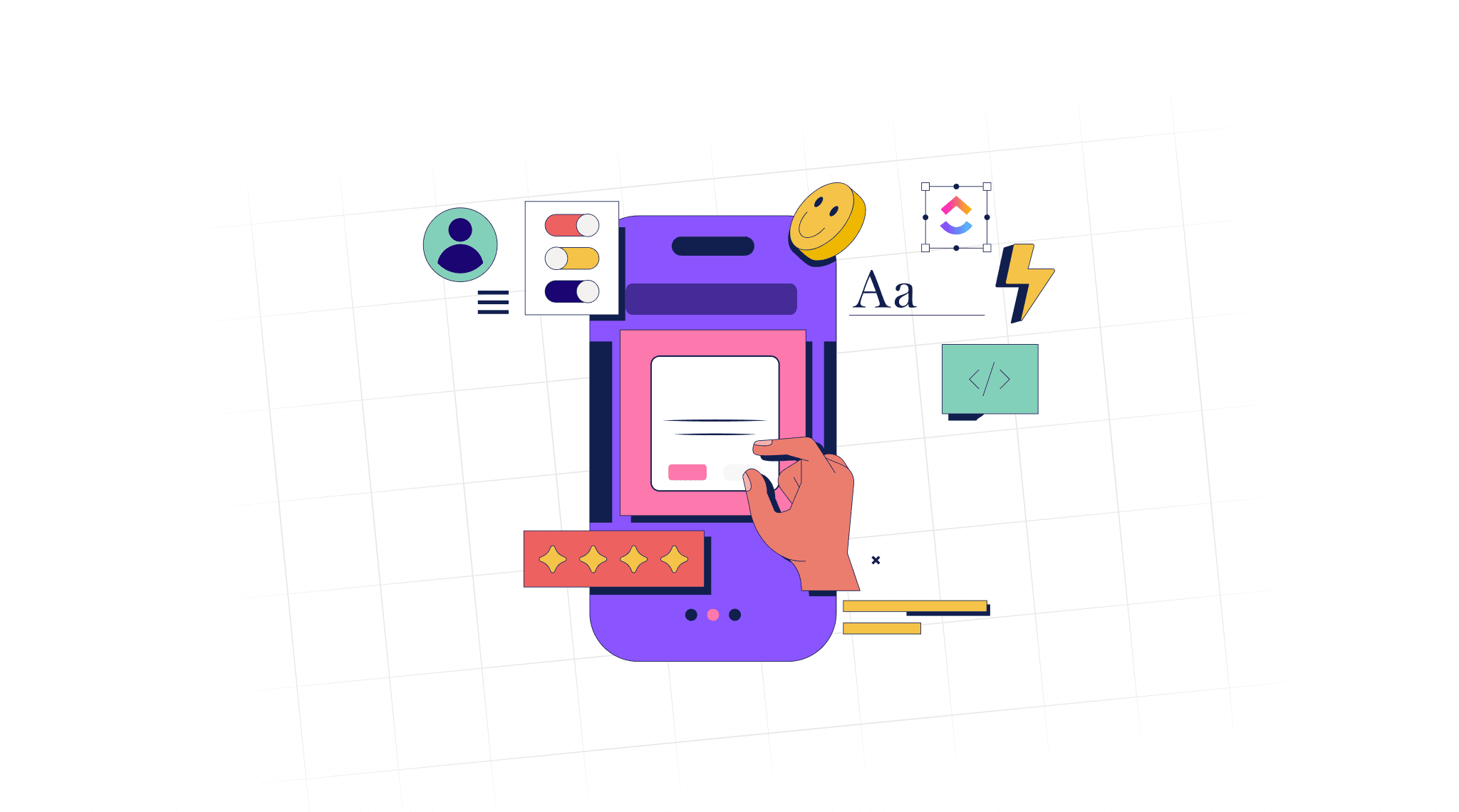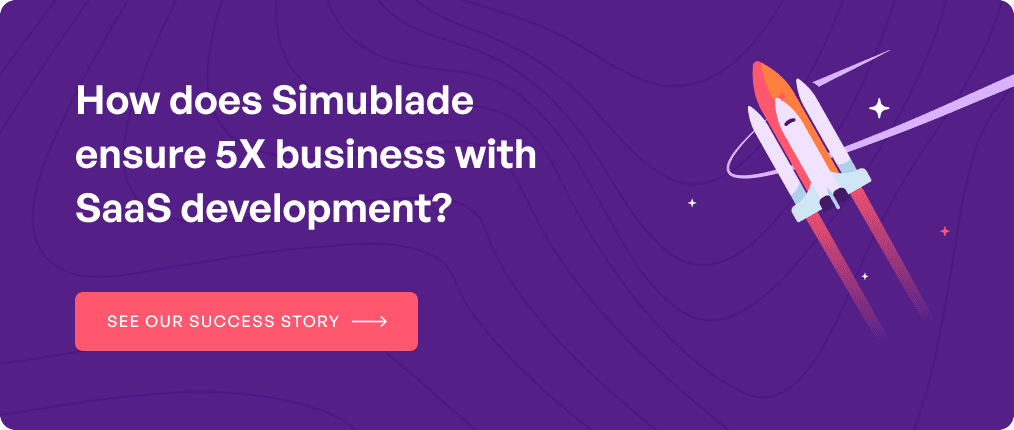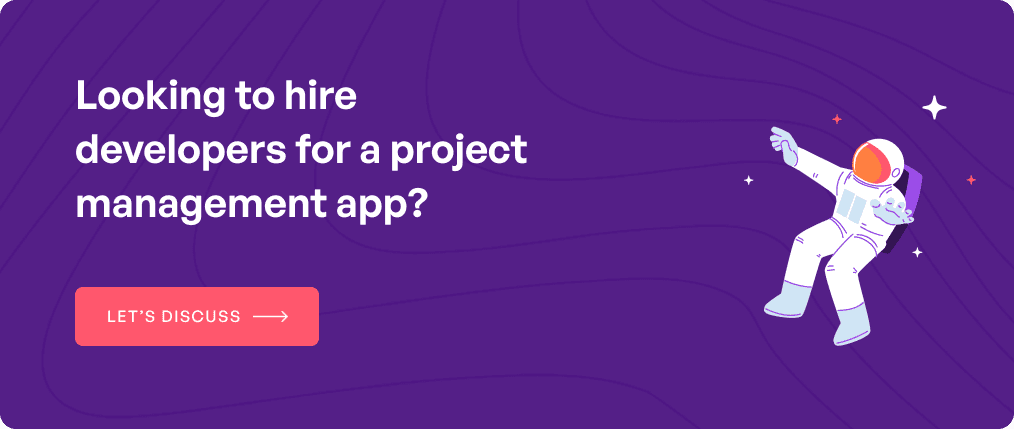ClickUp is a cloud-based all-in-one project management platform with a powerful way to handle a remote team with countless customization features, attractive interfaces, and scalable architecture. The app successfully removes geographical barriers, offering employees the freedom to work freely from anywhere.
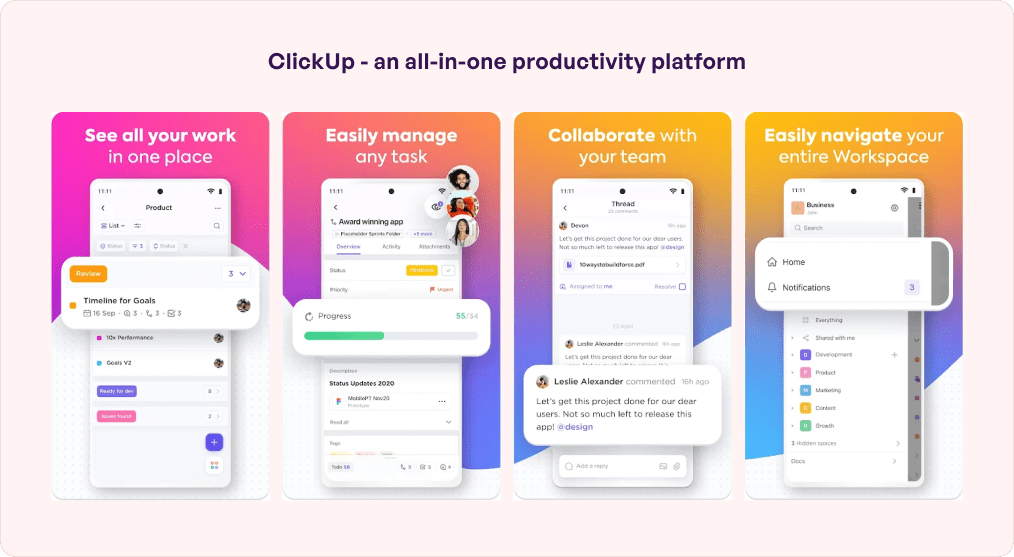 As a result, currently, more than 800,000 teams are using it to boost business proficiency. Overall, ClickUp has emerged as one of the most sophisticated project management software in the world. The timing of such a project management platform launch is apt since 45.8% of remote managers have stated that a lack of proper coordination is a big roadblock as it leads to :
As a result, currently, more than 800,000 teams are using it to boost business proficiency. Overall, ClickUp has emerged as one of the most sophisticated project management software in the world. The timing of such a project management platform launch is apt since 45.8% of remote managers have stated that a lack of proper coordination is a big roadblock as it leads to :
- unclear guidance and instructions
- conflicts and disengagements
- poor efficiency and productivity
- longer employee training process
These are the result of fragmented communications across multiple tools. So, planning to build a project management app like ClickUp is a highly strategic choice for your organization. The software will close the gap in the alignment of workflow and objectives and ensure maximum visibility into projects. Keep reading this article for a detailed roadmap to kick-off the best project management app development.
Table of contents
What are the initial steps to build a project management app like ClickUp?
Building the best-in-class project management app is nothing short of an investment. It has several advantages like cross-functional coordination, risk management, ease of resource allocation, automated project planning, features flexibilities, and a centralized system altogether. Let us go ahead and know the steps to SaaS application development.
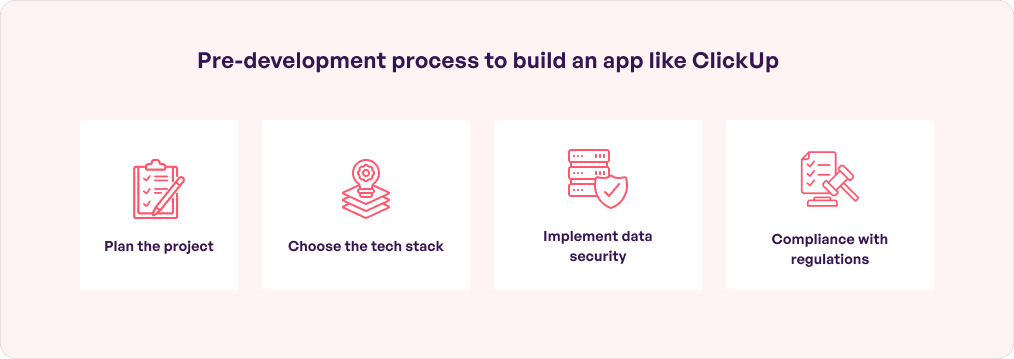
Plan the project
Consider assessing your business needs first. For instance what features and capabilities are missing in your current software? How do you expect the management app to fill them? Do you have any special requirements to be integrated? Finding an answer to these questions can help you deeply recognize and determine the app’s end-goal. Now you are able to convey the business objectives to the developers. Accordingly, they can plan a software development process and build a product that fits flawlessly. You rest assured that the final product will be innovative and futuristic, built via a combination of advanced languages, frameworks, and expertise.
Choose the tech stack
The benefits of a robust tech stack is incredible. However, not being able to integrate the right ones possess significant business risks. This is where Simublade, the best SaaS application development service providers, come in. Our developers are knowledgeable with years of experience in tech solutions. We are successfully able to blend time-tested and new-gen technologies in your business software along with strong security against cyber threats to help you win the competitive race.
The core technologies we work with include blockchain, AI, AR/VR, and IoT. We further take pride in our competence in Java, Python, Kotlin, Swift, iOS SDK, Grafana, Oracle, Docker, and Kubernetes (K8s) to name a few. Altogether, these help us in successful coding, architecture-building, and deployment.
Implement data security
Data and code are business assets. These must be protected from exposure to malicious activities so your operations are not derailed. This is why powerful cybersecurity is critical for a project management app to cover sensitive data. It also helps prevent the exploitation of code and infrastructure vulnerabilities.
At Simublade, we integrate AI in data privacy and provide multi-factor authentication, endpoint detection and response, disaster recovery plan, data encryption, network monitoring, vulnerability management, and a complete security strategy. All of these procedures are done via meticulous traffic analysis and penetration testing.
Compliance with regulations
Several federal laws are in place to preserve data. This includes HIPAA, COPPA, U.S. Privacy Act of 1974, Gramm-Leach-Bliley Act, and CCPA (US version of GDPR). Our developers ensure compliance with all of the above for responsible software development and management. We are especially careful while serving foreign clients and abide by legal requirements of their countries. This helps them avoid serious lawsuits or charges against their businesses down the line. For instance, we understand the role of AI in software development and hence follow the EU AI Act for a trusted AI framework. Further, our team is also careful about the ethical and legal GenAI considerations.
What are the core steps to build a successful project management platform?
After all the above criteria are satisfied, the main development process begins. These are the fixed chronology of steps that are followed to create an innovation-first project management platform. The end product is a true representation of your brand and helps to improve both employee productivity and company’s revenue.
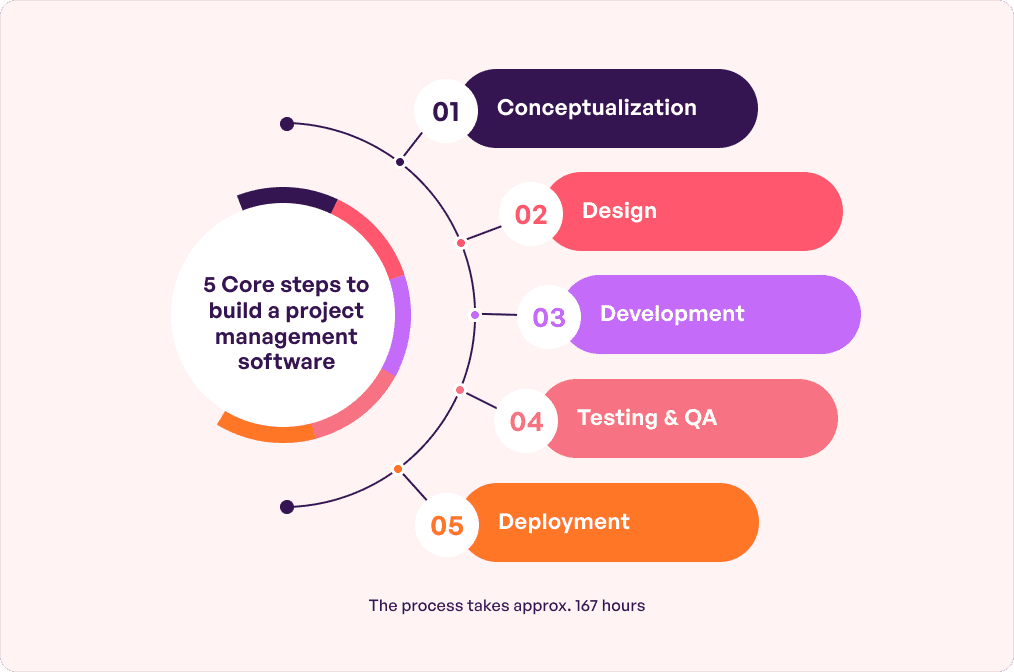
Step 1: Conceptualization
SaaS-focused business analysts discuss your needs first. So, convey your objectives and goals that you wish to tick off via the project management tool. You may refer to the points we discussed previously in this article. To streamline this process and ensure transparent ideation, developers can recommend a discovery workshop. You can also opt for a design sprint session to see what your finished product will look like along with validations from end-user validations. Altogether, there are fewer doubts and low risks of zero market acceptance.
Step 2: Design
This is the stage of brainstorming and formulating the UI/UX design. Our developers at Simublade strive to merge technology with human-centric design. A lot of micro-interactions, deep market insight, brand storytelling, mind-mapping, and designing elements go into the process. Our research and tech prowess help create a product that is a conversion magnet.
Step 3: Development
This is when clean and secure codes are written to start the SaaS app development. The concept and design are engineered into a clickable product. The developers work on backend, frontend, DevOps, and the overall architecture of the software. The end-result is scalable, fruitful and completely market-ready. We ensure the turnaround time is as fast as possible and the project management software is able to contribute to your company’s success.
Step 4: Testing and QA
This step in building a project management app is crucial since it involves rigorous quality assurance with multiple steps and cybersecurity. The developers perform functional testing, unit testing, API testing, integrated testing, performance testing, automation testing, load testing, security testing, and accessibility to ensure the product is efficient and secure enough to offer a rich and intuitive user experience. All of these are done by combining multiple tools, technologies, and approaches.
Step 5: Deployment
The SaaS product can either be released to the masses or integrated into an existing system. The success of the product will depend on its acceptance by the staff. At this point, developers suggest hands-on training to team members for better adoption.
In the end, ongoing support and maintenance are a part of project management software solutions and are offered to ensure appropriate working of the app. Hire developers like us who can perform design upgrades, bug fixes, and add new features to ensure constructive interaction between the organization.
Which ClickUp features can you replicate in your project management app?
The annual revenue of ClickUp is $150 million(Jan, 2023) and is likely to grow to $200 million in 2024. What drives these staggering figures for this project management app? Well, it has exceptional features and designs, a combination which offers impressive functionalities. The best part is that no technical prowess is mandatory to operate it. Now, let us explore the out-of-the-box features to build something similar and help team members to become proficient. Take time to read and understand each project management platform features of ClickUp carefully.
- Space, Folder, and List : Space allows separating multiple departments and teams. This helps achieve several objectives leading to a common end-goal. Folder (big projects) and List (smaller tasks) are subsets of Space. Overall, it is a clear hierarchy of how the platform works.
- Customizable tasks : Users can choose from over 35+ ClickApps to personalize the dashboard aligned to their distinct needs. No codes are required.
- Nested subtasks & checklists: Checklists are allowed within tasks to keep a track of multi-step workflows which otherwise might be confusing.
- Automation: Routine tasks and processes can be automated with 50+ triggers, actions, and conditions which is made even easier since ClickUp features pre-built or customized options.
- Templates:Tasks, checklists, team use cases, and Docs can be leveraged with 100+ templates. For instance, it includes apparel designs, architectural designs, brainstorming, brand identity, scum management, and book planning to name a few.
- Relationships: Multiple tasks can be linked in one place. For instance, link clients to deals, customers to orders, or bug reports to users. The app also enables users to add ‘waiting on’ or ‘blocking’ to set clear task priorities.
- Integrations: ClickUp integrates with 1,000+ tools. Organizations can sync cloud storage, team calendars, messaging apps, and anything similar under one roof.
The other features include Dashboards, Workload & Box view, Goals, Milestones, Pulse, Tracking, Estimates, Reporting, Task Management, and Team Collaboration. Overall, ClickUp is like a visual canvas of ideas and workflows. So, it is possible for remote teams to come together and work on any project without hiccups while staying up-to-date, real-time.
What is the cost to build an app like ClickUp?
The cost to build project management software can vary between $25,000 and $50,000. However, it depends on how complex the app is. Additionally, embedding AI will require $20,000 to $200,000.
Businesses can start with an MVP, which is comparatively, affordable than launching a full-fledged app right in the beginning. It gathers feedback from early adopters which will help tweak the app and ensure maximum market viability.
What are the key factors affecting the cost to build an app like ClickUp?
There are several factors that influence the overall cost of an app. An overview will help in proper investment or tweak your budget as required.
- Platform: Cross-platform app development is less costly since there are single codes, development tools, languages and maintenance. On the other hand, native apps are meant to run on specific platforms like iOS, Android, or Windows. Developing them is a costly alternative.
- Technicalities: Simplicity of technicalities like algorithms and backend processing will lower the overall cost to build an app like ClickUp. However, if these are complex, the pricing will automatically be higher.
- Features: Basic apps with simple features and functionalities need basic resources. So, you do not have to invest a chunk of your capital. However, complex features like payment gateways, AI chatbots, or geolocation will increase the charges.
- UI/UX design: Intricate designs of elements like buttons, icons, colors, dropdowns, forms, and breadcrumbs typically require high-end resources, plenty of time, and specialized expertise. This will impact the cost of building the platform.
- Tech stack: The type, number of tools along with their capabilities are significant factors that impact the app building expenses. Ensuring compatibility is another major aspect when calculating the cost of the total tech stack.
The other basic factors are scalability, flexibility, maintenance and updates, design needs, geographical location, and developers fees.
What are the core tools and technologies used to build a project management app like ClickUp?
ClickUp has been built with 33 tools and technologies. This includes Angular2, Node.js, ExpressJS, SaaS, TypeScript, SQL, Ruby, and CSS3 to name a few. Below is a list for an in-depth understanding.
| Utilities | Tools |
|---|---|
| Development | Git |
| Development hosting | Amazon Web |
| Data storage | Slick and PostgreSQL |
| Analytics | Hotjar and Wistia |
| Design | Figma |
| Communication | SendGrid |
| Payments | Stripe |
| App utilities | Mutiny, Postman, and FullStory |
However, businesses are free to choose other programming languages, SDLC methodologies, and frameworks to build an app which takes management to the next level.
What are the legal considerations of building the best project management app?
Taking care of the legal aspect is essential for both startups and enterprises. It helps protect the commercial interest of your business and prevents dire consequences. Below is a list of what companies must address.
Trademark
Whether or not the app involves revenue, trademark is a must. It protects your business’ name, logo, colors, sounds, and symbols. Else, your competitors might start offering similar services which impacts revenue and dilutes your brand value. By registering a trademark, you also know if you are conducting an infringement of an existing mark. Considering opting for marks under U.S. Patent and Trademark Office since it is the highest degree of protection in the federal courts.
Copyright
Protect your app idea, source code, design, and textual elements under the US Copyright Act of 1976. So,the original work cannot be copied without your permission. You can use this legal weapon to support your intellectual property claims during disputes. Do learn the specific lifecycle of copyright protection to make informed decisions.
End-user license agreement (EULA)
This is a legal contract between the software development company and your business. It specifies a license which is provided solely to use the product without ownership rights. This contains the terms of conditions along with meticulously defining user’s rights. However, the vendor does not take the responsibility of software damage.
App store agreements
There are a few concrete App Store and Google Play Store regulations for applications. Make sure to understand and abide by each one before launching your project management app. For instance, Metadata on the App Store must not contain the price and terms of the product. Further, businesses will be solely responsible for data fees incurred from third-parties on the Google Play Store. You must also go through government regulations around taking your app to the public.
Legal compliances
We discussed previously that GDPR, CCPA, HIPAA, PCI DSS, or FTA Act are applicable major industries dealing with mobile app development. Try to stay compliant by discussing these legal frameworks with your team of developers. It will help ensure data privacy and fair usage of the app while being at par with the industry standards.
The key components of building an app like ClickUp includes project planning, collaboration, communication, resource management, reporting and analytics, inventory management, and risk management. Try to research and analyze each one to see where you can improve. It will help you build a project management app that is a superior alternative to ClickUp.
FAQs
Q. How to build a project management app like ClickUp?
Ans. The core steps include planning or conceptualization, choosing tech stack, development, launch and post launch maintenance. The right way to transform your idea into a product is to get in touch with us at Simublade.
Q. How long does it take to build a project management software like clickUp?
Ans. It takes approximately 4 to 9 months to build custom project management platforms. You can get started by building an MVP in 12 weeks from Simublade.
Q. What are the common features of a Project management tool?
Ans. A project management app will typically consist of useful features like project dashboards, audio/video calling options, collaborative spaces, tracking and reporting, automation, budget tracking, resource management, and filing and documentation.
Q. How much does it cost to build a project management platform?
Ans. The human cost to build project management software is around $37,500. However, it depends on the level of app complexity. So, businesses can expect the expenses to vary between $25,000 and $50,000. AI development and integration might require $20,000 to $200,000, in case you are considering the technology.
Q. How do the features and functionalities affect the overall cost of the development process?
Ans. Simple apps with primary features and functionalities require low development hours, and basic tools, techniques, and tech stack. Further, specialized expertise is not mandatory. So, businesses do not have to invest a chunk of their capital. However, complex features like payment gateways, AI chatbots, AR/VR, and geolocation will increase the charges.


